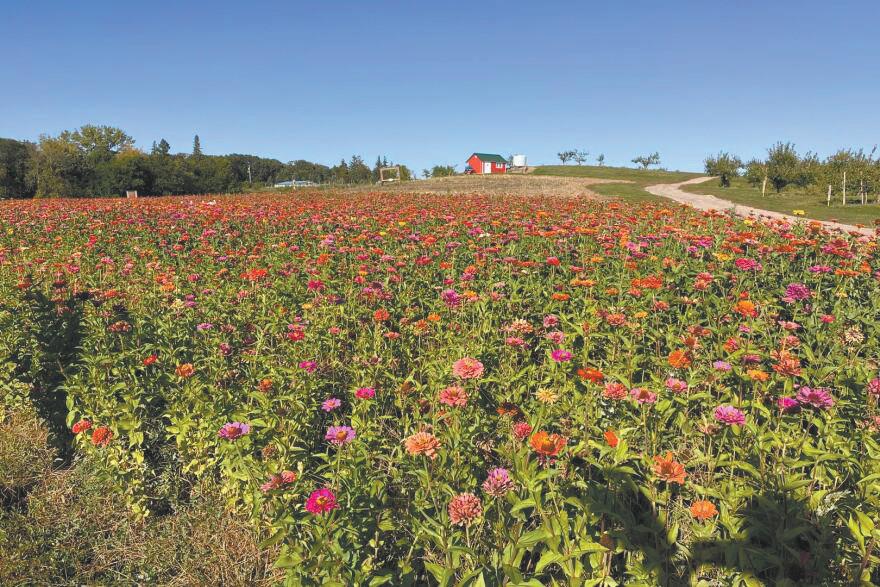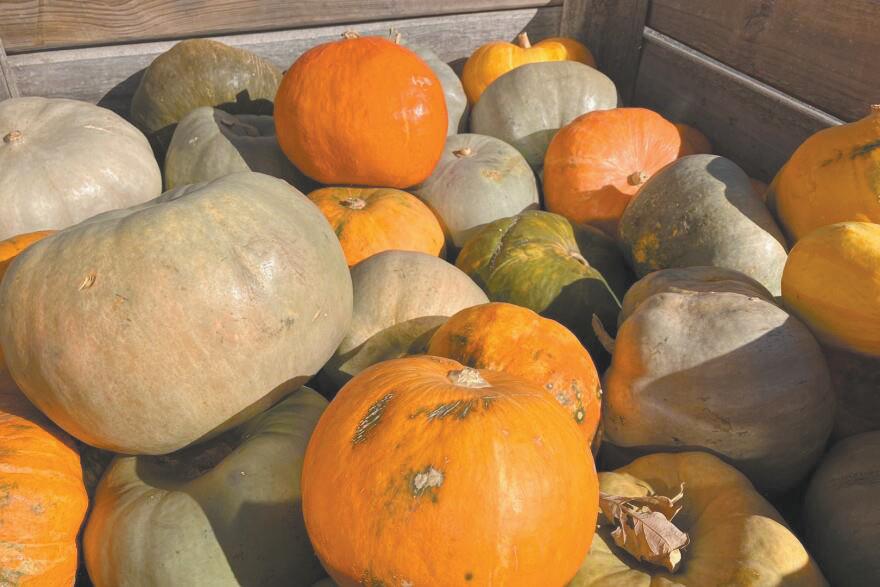

OUR
hometown


A Christmas Carol
A miserly and miserable man, Ebenezer Scrooge greets each Christmas with “Bah! Humbug!” until he is visited one Christmas Eve by the Ghosts of Christmas Past, Christmas Present and Christmas Future.


Registration packets available at any of our 8 branch locations or register on our website: fsbwc.com/personalbanking/prestige-club/upcoming-travel/prestige-club-tripregistration Contact: Kim Peck; Prestige Club Coordinator Phone: 515-832-2520 Email: kimp@fsbwc.com When: Wednesday, December 11, 2024 Where: Guthrie Theater ~ Minneapolis, MN

Motor coach transportation to and from The Guthrie Theater in Minneapolis, MN

Catered lunch provided by Show tickets All tax and gratuities A day full of magic and fun! y





Tapper is Master Farm Homemaker FCS teacher works to make the House a Home

Scott & Lisa Tapper at the gazebo of their farmhouse east of Webster City.
By Lori Berglund
It’s never really been about the house for Lisa Tapper. It’s always been about the home.
Tapper, a veteran Family and Consumer Science teacher, was happily surprised a few years ago when she was named an Iowa Master Farm Homemaker. But then, homemaking has always been her goal since her days as an Iowa State University student back when FCS was still called Home Economics.
“I was still working full-time, so it was a surprise,” Tapper said of the award. “They told me the award looks at women who are active on the farm and active in the community.”
Tapper has been very involved in both church and community activities. She’s served on the Hamilton County Extension Council, volunteered as a 4-H leader, Sunday school teacher, and even played the organ for her church near Kamrar.
All the while, she and husband, Scott, also raised three children — Mark, Matthew, and Katie — on their farm east of Webster City. Now retired from teaching Family and Consumer Science, Tapper is a “full-time gopher” for the family farm operation.
“I did some of that when I was still working, but I do a lot more now,” Tapper said. “I’m pretty much on the road, racing meals to the field, going to get parts, or just whatever is needed.”
The couple met when they were both students at Iowa State in the late 1970s. After marriage and graduation, she went to work teaching, and he joined his father, the late Weldon Tapper, on the family farm.
For Scott, the same house has been his home most of his life. Aside from his years at Iowa State, and then the first few years of marriage when he and Lisa lived in a house just down road — within hollering distance — he has always lived in the home his dad built in 1952.
“It’s pretty awesome,” Scott said of his long connection to the same farmstead.
Son Mark and his wife, Hildi, now live in the house down the road with their children. It makes it handy for visits to grandparents, and home-made milkshakes after the school bus lets them off on sunny autumn afternoons.
For Lisa, moving in to the house that had been home for her in-laws meant that she joined the
legions of farm women who, for generations, have faced the task of making the old family home, her own family home.
“I was surprised because sometimes it’s the littlest things that mean so much to someone else,” Tapper said.
She remembers well when she painted the kitchen grey instead of the turquoise that had been there. While it matched the flooring, it was met with a little disappointment from her mother-in-law, the late Anne Tapper.
Tapper said being flexible is an important trait for young farm wives as they navigate their own way in the family farm operation. She learned to be patient, but to still move confidently ahead with the changes she wanted to make, putting her own stamp on the family home.
The couple has twice renovated the kitchen, but kept the budget very low each time. The first renovation was little more than adding trim to the cabinets. The second renovation was larger, taking down a wall between the kitchen and dining room to create one larger space.
“That way we could all eat at the same table,” Tapper explained.
The couple also put on a large addition to the first floor, adding a master bedroom and more living space. One of the renovations she is most proud of is the porch and screened-in gazebo.
The gazebo was a trade-off with her husband. He was looking to put up a new hog building, and she agreed, with the provision that they also do a gazebo.
“I think it was a good trade-off,” Tapper said with a smile.
Indeed, the gazebo is a comfy place to sip a cup of lemonade or read a book. Grab a quilt from the house, and the season to enjoy the gazebo extends later into the fall and early spring.
Homemaking, especially on the farm, is never just about the house, it’s always about making a home where all are welcome and warmly invited to sit and enjoy a little visiting together.
Apple orchards, pumpkin patches & flower fields:
Cramer/Iowa Public Radio
Story and Photos by Rachel
Iowa farmers see the growing success of agritourism
Income from agritourism in Iowa has more than doubled in recent years. Farmers are getting more creative to draw in the crowds.
Just north of Fort Dodge, Denny Stucky inspected an apple tree ready for harvest.
“These are Haralson apples,” Stucky said, pulling one off a branch. “They are a very versatile apple. They’re good eating and excellent for baking.”
Stucky and his wife, Emily, own and operate The Community Orchard, where there are nearly 6,000 apple trees and 14 varieties.
Visitors buy them by the bag. But Stucky emphasized that this 100-acre property relies on much more than apple sales.
“It’s very important to have a full day’s experience here at the orchard,” Stucky said. He pointed at a large white building. Inside the Apple House staff in the café wiped down tables after the lunch rush. Shoppers walked upstairs to the boutique or over to the market to buy jams, donuts and cider.
Denny Stucky stands next to one of his apple trees.
Many of the apples are baked into pies and other treats that are sold in the cafe and market. The orchard also produces 8,000-10,000 gallons of apple cider each year. A winery down the road and a brewery in Fort Dodge turn some of it into hard cider and beer.
Outside, kids bounced on a giant jumping pillow and ran across a farm-themed playground. Families fed goats and picked out gourds in the pumpkin patch.
Stucky said a crisp October weekend can draw in 10,000 visitors.
“We’ll spin a couple thousand caramel apples every weekend to prepare for those,” Stucky said.
The Community Orchard is one of nearly 400 farms in Iowa that generates at least some income from agritourism. It’s the idea of selling experiences — not just products — on a farm.
Zinnias continue to bloom as summer fades into fall. Denny Stucky said he planted this and a sunflower field earlier this year as part of an ongoing effort to create new attractions. During a flower festival at the orchard, visitors paid to cut their own flowers. It was also a popular spot for wedding proposals and high school senior photos.

Rachel Cramer/Iowa Public Radio
Denny Stucky stands next to one of his apple trees. Many of the apples are baked into pies and other treats that are sold in the cafe

Traditional forms of agritourism include letting visitors pick their own apples, pumpkins and Christmas trees. In recent years, it’s become much more diverse. Some offer glamping and specialty dinners with local chefs. Others host flower arranging workshops, live music and food trucks. Paintball and pumpkin cannons are another option.
“We hear a lot about big farms getting bigger and small farms finding it challenging to be as sustainable,” said Kendra Meyer, a program specialist with the small farms team at Iowa State University Extension and Outreach and coordinator for the Visit Iowa Farms program. “Agritourism provides opportunity for some of these small farms to stay a small farm but be sustainable and diversify their operation to increase their revenue.”
After steadily increasing for more than a decade, on-farm income from agritourism in Iowa jumped from $4.8 million in 2017 to $10.2 million in 2022, according to the latest U.S. Census of Agriculture, which was released in February. The number of farm operations with agritourism income increased by 10% across the same five-year span.
Meyer said COVID-19 spurred a lot of the growth. People were eager to get out of their homes and pandemic routines.
“They could experience those farms still in a way that was comfortable and safe for them,” Meyer said.
Near the Apple House, the Stuckys planted a nearly 5-acre corn maze.
Inviting visitors to a farm does comes with some new hurdles for the owners. They need liability insurance and licenses to sell food. Meyer’s team offers resources to cover this and other areas of risk management.
A large crate holds pumpkins and others types of squash at The Community Orchard.
Agritourism may also require more time planning events and dealing with logistical headaches, said Dan Fillius, an ISU Extension field specialist for commercial vegetables and specialty crops.
“[Agritourism] doesn’t work for everybody. But for those who really are into the hospitality side of things, and catering to that experience, it can make a lot of money and be quite lucrative for farmers,” Fillius said.
He expects agritourism will grow and diversify in the coming years.
“People continue to move to urban centers and have that nostalgia for what they had growing up, or what their families longer ago had and that they seek to return to,” Fillius said.
Even if it paints an idealized version of farm life, Fillius and Meyer said agritourism can help people understand and appreciate where their food comes from.
Rachel Cramer/Iowa Public Radio
Near the Apple House, the Stuckys planted a nearly 5 -acre corn maze.
Zinnias continue to bloom as summer fades into fall. Denny Stucky said he planted this and a sunflower field earlier this year as part of an ongoing effort to create new attractions. During a flower festival at the orchard, visitors paid to cut their own flowers. It was also a popular spot for wedding proposals and high school senior photos.

Zinnias continue to bloom as summer fades into fall. Denny Stucky said he planted this and a sunflower field earlier this year as part of an ongoing effort to create new attractions. During a flower festival at the orchard, visitors paid to cut their own fl owers. It was also a popular spot for wedding proposals and high school senior photos.

Back at The Community Orchard, the families have left for the day. The sun hangs low by the bank of the Des Moines River. Couples and small groups of friends gather at the entrance of a corn maze for an adult-only “Wine Your Way Out” event. Samples of hard cider and beer — made with apples from the orchard — are scattered throughout.
A sign for The Community Orchard sits on a vintage red truck on the property near Fort Dodge. Denny and Emily Stucky bought the orchard in 2022 as first generation farmers. Denny said they spent a year with the previous owners "learning the ropes" and cont inue to add new attractions and events to draw in more visitors.
A sign for The Community Orchard sits on a vintage red truck on the property near Fort Dodge. Denny & Emily Stucky bought the orchard in 2022 as first generation farmers. Denny said they spent a year with the previous owners “learning the ropes” and continue to add new attractions & events to draw in more visitors.
Brittney Arndorfer drove over an hour from Swea City, near the Minnesota border.
“I grew up coming here as a little kid. Now I feel like there are more things for adults to do,” Arndorfer said.
Rachel Cramer/Iowa Public Radio
Rachel Cramer/Iowa Public Radio
She
“This
Frommelt
They













Rachel Cramer/Iowa Public Radio
A large crate holds pumpkins and others types of squash at The Community Orchard.
How to make a
Home Fire Escape Plan Home Fire Escape Plan
Draw a map of your home. Show all doors and windows.
Visit each room. Find two ways out.
All windows and doors open easily. You should be able to use them to get outside.
Make sure your home has smoke alarms. Push the test button to make sure each alarm is working.
Pick an outside meeting place a safe distance from your home where everyone should meet.
The house or building number can be seen from the street.
Make sure your plan meets the needs of all your family members, including those with sensory or physical disabilities.
Everyone in the home should know the fire department’s emergency number and how to call once they are safely outside.
Practice your home fire drill at least twice a year with everyone in the household, including guests. Practice at least once during the day and at night.
Sample Escape Plan
Sparky® is a trademark of NFPA®. ©NFPA 2023
Meeting Place
Green Asparagus Wrapped In Roast Beef

Makes 4 servings or 8 appetizers
8 thick asparagus, woody ends removed
8 slices roast beef, cold, trimmed of excess fat and gristle
1 cup cottage cheese
2 scallions, or spring onions, chopped
Salt Freshly ground black pepper
1. Blanch the asparagus spears in a large saucepan of salted, boiling water for 2 to 3 minutes until tender to the bite.
2. Drain and refresh immediately in a large bowl of ice water. Remove from the water after 3 minutes and pat dry. Season with salt and pepper.
3. Spread the slices of roast beef with the cottage cheese. Place an asparagus spear at one end of the slice and roll into a cigar shape, enveloping the asparagus in the center.
4. Arrange on a platter and sprinkle with chopped scallion before serving.
courtesy of Lines+Angles
realizar un
plan de evacuación por planincendio de evacuación por incendio Cómo
Visita Sparky.org para mas actividades!
Dibuje un mapa de su hogar. Incluya todas las puertas y ventanas.
Revise cada habitación. Encuentre dos salidas.
Todas las puertas y ventanas deben abrirse fácilmente. Debe poder utilizarlas para salir.
Asegúrese de que haya alarmas de humo en su hogar. Presione el botón para asegurarse de que las alarmas funcionen correctamente.
Escoja un punto de encuentro en el exterior. Deberá estar en frente de su hogar.
Todos se reunirán en el punto de encuentro.
Asegúrese de que el número de su hogar o edificio pueda verse desde la calle.
Comente el plan de evacuación con todos los integrantes de su hogar.
Memorice el número de emergencia del departamento de bomberos.
¡Practique el simulacro de evacuación por incendio!
Realice su propio plan de evacuación por incendio utilizando la cuadrícula proporcionada en la página 2.





Danielle Michalski,

Photo #2

by Jim Miller
If You’re 65 or Older,
It’s Time to Get Your Pneumonia Shot
Dear Savvy Senior , I recently turned 65 and would like to know if am supposed to get the pneumonia vaccine? And if so, which type of vaccine do I need and is it covered by Medicare?
Dear Relatively,
Yes, the Centers for Disease Control and Prevention (CDC) does indeed recommend the “pneumococcal vaccines” for pneumonia for adults age 65 and older. They’re also recommended for younger people with long-term health issues or weak immune systems, as well as children under 5 and people who smoke.
Pneumonia, which can happen anytime – not just during the cold months – can be a serious and even life-threatening condition. Each year, pneumonia causes a whopping 1.5 million people to visit medical emergency departments in the U.S. and causes roughly 50,000 deaths.
A recent study found that the use of pneumonia vaccines is associated with a 24 percent decreased risk of death, but vaccination rates aren’t that high.
Around 67 percent of adults over the age of 65 are vaccinated against pneumonia, and just 24 percent of younger people (19-64 years old) at risk for pneumonia are vaccinated. The main reasons for this are because many people are unsure whether they need the vaccine, while others aren’t even aware a vaccine exists.
Types of Vaccines
There are three different vaccines available, some more appropriate for certain people than others. They are the pneumococcal polysaccharide vaccine PPSV23 (Pneumovax23), the pneumococcal conjugate vaccine PCV15 (Vaxneuvance) and PCV20 (Prevnar 20). The numbers indicate how many strains, or serotypes, of streptococcus pneumoniae are included in the vaccine.
So, which vaccine should you get?
If you’ve never been vaccinated for pneumonia, the newer PCV20 is the top choice – it covers the 20 most common serotypes now. If that vaccine is not available in your area, you can get the PCV15 vaccine, followed one year later by PPSV23.
If you had the earlier PCV13 (but not PCV15), or the PPSV23 at or after age 65, you’re likely eligible to get the PCV20 for increased protection.
But because of the different possibilities, you need to talk to your doctor or pharmacist about the most effective option for you.
Side effects of these vaccines tend to be mild, but may include feeling achy and tired as well as redness, swelling and soreness where the injection was given. You’ll also be happy to know that Medicare Part B covers both single dose and two-dose pneumococcal shots, and you only need to get it once. Unlike the flu shot, which is given annually.
Most local pharmacies and community health clinics offer pneumococcal vaccines, but you may want to call ahead just to be sure.
For more information, visit the CDC’s Pneumococcal Vaccination webpage at CDC.gov/vaccines/vpd/ pneumo/index.html.
Other Vaccines
To avoid getting pneumonia as a consequence of a viral infection, you should also consider getting a flu shot, RSV shot and a Covid-19 booster in the fall.
While vaccines cannot prevent every case of pneumonia (or other conditions they’re given for), those who get them usually have milder infections, a shorter course of illness and fewer serious complications than people who don’t get vaccinated.
The flu shot and Covid booster are both covered by Medicare Part B, while the RSV vaccine (which is recommended every other year) is covered under Medicare (Part D) prescription drug plans. All three shots can also be given simultaneously.
Memorize your fire department’s emergency phone number and write it below:
How to make a
Home Fire Escape Plan
• Draw a floor plan or a map of your home. Show all doors and windows
• Mark two ways out of each room.
• Mark all of the smoke alarms with SA . Smoke alarms should be in each sleeping room, outside each sleeping area, and on every level of the home.
• Pick a family meeting place outside where everyone can meet.
• Remember, practice your plan at least twice a year! Sparky® is a trademark of NFPA. ©NFPA 2023
Grown-ups: Children don’t always wake up when the smoke alarm sounds. Know what your child will do before a fire occurs. For more fire safety resources, visit sparky.org and sparkyschoolhouse.org
Visit Sparky.org for more activities!
Memorice el número de emergencia del departamento de bomberos y escríbalo debajo:
Cómo realizar un
plan de evacuación por incendio
• Dibuje un plano o mapa de su hogar. Incluya todas las puertas y ventanas
• Señale dos salidas en cada habitación.
• Señale todos las alarmas de humo con la sigla AH . Debe haber una alarma de humo en cada dormitorio, fuera de cada dormitorio y en cada planta del hogar.
• Escoja un punto de encuentro familiar en el exterior para reunirse.
• Recuerde, ¡practique el plan de evacuación, al menos, dos veces al año!
Adultos: Los niños no siempre se despiertan con el sonido de una alarma de humo. Verifique el proceder de su hijo antes de que ocurra un incendio. Obtenga más información sobre alarmas de humo y planes de evacuación en www.nfpa.org/factsheets
Sparky® es una marca registrada de NFPA. ©NFPA 2022
Visita Sparky.org para mas actividades!
Punto de encuentro



























ShotParting

Van Diest Family Health Clinic proudly offers 3D Mammography exams, showing more detail and detecting cancer earlier than ever before!



515.832.7800 to schedule your mammogram today! *Schedule your mammogram in the month of October or November and be entered to win a gift basket!






